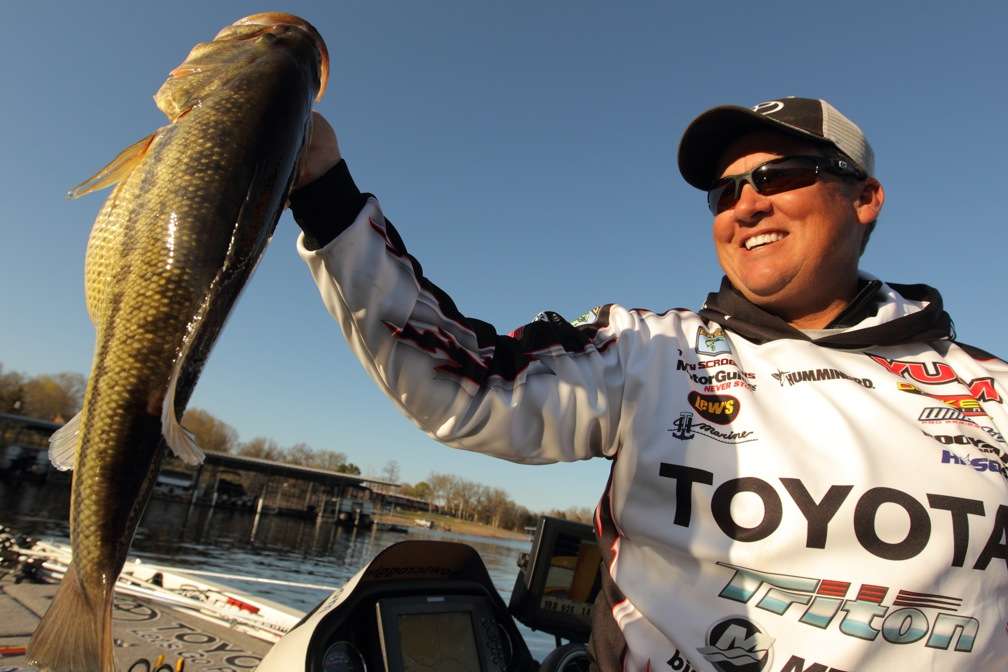
Few anglers in the world fish aquatic vegetation more effectively than Elite Series pro Terry “Big Show” Scroggins. Here are his simplified tips for picking apart the weeds more proficiently.
1. First, find the haystack in the hayfield, before you look for the needle
“A lot of fishermen become immediately overwhelmed by a lake full of vegetation. But really, it’s as simple as finding something different or unique among several other acres of aquatic vegetation,” says Scroggins, a former autobody technician. “Focus on finding the pocket, focus on finding a point, focus on finding an isolated floating mat of hyacinths amid several acres of hydrilla or milfoil. The point is, look for something that sticks out, or something unique,” says Scroggins.
2. If you hate picking weeds off your lure after every cast, try using a much bigger weight
“Nobody likes to pick weeds off their lure after every cast, but a lot of that aggravation can be avoided if you’ll use a super heavy 1 1/2-ounce weight to rocket your lure through the pads or grassbeds, as well as when pulling the lure back up through it on the retrieve,” says Scroggins. “A weight that big scares a lot of anglers. I even see some Elite Series anglers trying to fish with weights in the weeds that are way too small, but I’m telling ya’ – go big!”
3. Going big applies to hook, line and fishing rods, too
“I use 65-pound braid, tied to a 6/0 hook on a heavy action fishing rod at least 7-feet long nearly all the time when I’m pitching the grass,” emphasizes Scroggins. “Heavy braid is a must for fishing around weeds for three reasons. First, if you’re using that huge 1 1/2-ounce weight, like you should be, you’ll need heavy line paired to your heavy weight. Secondly, you need plenty of pulling power to free the bass from the weedbed once you get a bite. And thirdly, if you do get snagged, braid makes pulling free a whole lot faster and easier.”
4. Frogs above and tiny craws below
“If I had two lures for the rest of my life to fish vegetation, it’d be a Yum Big Show Craw and a Booyah Pad Crasher frog. In other words, one lure for on top of the weeds (frog), and another lure for beneath them (craw),” said Scroggins. “It’s really, really important to use a small compact craw. For starters, most of the critters that live around matted vegetation like grass shrimp and sunfish are small, so you’re matching the hatch, and secondly, you can get a 3 1/2-inch compact bait in and out of the weeds a heck of a lot easier than a big bait like a creature bait.”
5. Still need convincing you can catch ‘em in the salad?
“Plan a trip to Guntersville, Ala., around Halloween if your confidence for fishing vegetation needs a boost. You’ll have plenty of new fishing friends around you. It’s a very popular reservoir, but the first time a 4-pounder busts through the weeds to eat your frog, or as the locals like to call it – ‘the cheese’ – your confidence will soar,” says Scroggins, reliving sweet memories of autumn days gone by on the northern Alabama fishery.
6. Have a ribeye with your salad
“Whether you’ve been casting a frog or pitching a craw, after a long day of fishing the salad, you’re gonna need to eat. I’d recommend a big old nasty ribeye soaked in teriyaki. In less than 20 minutes, you can fire up the grill and have your steaks thoroughly marinated in teriyaki. Cook it for 10 minutes total. Five minutes on one side. Five on the other. And you’re good to go,” concludes Scroggins, who shares all his favorite lures and recipes on his website: bigshowscroggins.com.
Originally published September 2012





